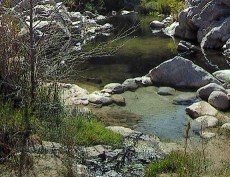Can goats' appetites avert blazes?
07/16/2003
By BEN GOAD
THE PRESS-ENTERPRISE
Managers of the overgrown San Bernardino National Forest have used everything from chemicals to prescribed fires to high-tech incinerators to get rid of highly flammable brush surrounding Inland mountain communities.
Now, as the potential for wildfire grows with the approaching dog days of summer, some area residents are clamoring for officials to bring on the goats.
Fire officials in Northern California, Colorado and Arizona are using several breeds of goats to clear forests and even residential areas of unwanted vegetation.
The goats can rapidly gobble large amounts of flammable chaparral, which could act as kindling for a major forest fire. They have also been proved environmentally friendly preservers of man-made break lines.
"I know goats," said Debbie Walstead, a co-founder of Wild Goat Womyn & Associates who has researched the use of forest-clearing goats in wildland and urbanized settings. "With the right planning, it works very effectively. It's what they do, they're a natural herbicide."
AP photo
Goats are clearing unwanted brush in many western states.
The call to use goats, or perhaps sheep, to munch away the local fire threat has some officials scratching their chins.
"We really ought to think about using tools like goats or sheep," Doug Pumphrey, lands and resources officer for the San Bernardino National Forest, said. "When you cut down trees, that brings out more grass and brush that you also need to remove."
With more than 350,000 acres of trees and brush ready to burn after four years of drought and widespread beetle infestation, people are ready to try about anything.
"Goats are the answer -- I can tell you that," High Desert resident and San Bernardino County real estate agent Bob Thacher said. "Those fools will eat anything."
Still, Pumphrey was a bit skeptical about implementing such a plan anytime soon.
"Goats themselves are hard to herd," he said. "I don't see it right now."
Pumphrey pointed to mixed results of a 3-year research project in which goats were used to clear brush in Riverside County's Cleveland National Forest. On the other hand, he noted success in the Angeles National Forest, where sheep are being used to maintain fire break lines.
"Oh, sheep are stupid -- and they only eat grass," Walstead, who lives in Colorado, said. "Don't even attempt it."
Goats used before
After the devastating Laguna fire of 1970, which destroyed 382 structures and blackened more than 175,000 acres across Southern California, the U. S. Forest Service began looking at unconventional ways to reduce brush.
In the Cleveland National Forest, they tried hooking up chains between two tractors and dragging them across the ground to uproot low-lying vegetation, Tom White, land management planner for the forest, said.
They even tried to sell compacted chaparral as briquettes, to be used as an alternative to charcoal in barbecue grills, White said.
It was during these projects that a herd of Spanish meat goats were brought to the Cleveland National Forest. For three years, forest officials chronicled the successes and failures of the hungry animals.
Based on the findings, which are contained in a 12-page report of the Cleveland project, White said the plan could make a difference in the San Bernardino National Forest, if combined with other clearing methods.
Herding vs. fencing
Goats, if left to their own devices, will browse only certain kinds of plants and do not take direction well, the report found. If herders are used to contain them, they must have experience and well-trained dogs, according to the report.
Also, goats are natural prey to mountain lions, bears and coyotes, all of which live in the San Bernardino National Forest.
The alternative to herding would be to construct fences or pens, which would force the goats to eat only in confined areas while keeping out predators, according to the report. The pens, forest officials discovered, must be made of netting or contain electricity to shock the goats rather than the barbed-wire fences usually used to contain grazing cows.
Though initially more expensive than hiring herders, the report concluded that building pens is likely more cost effective in the long run.
Goats vs. sheep
In 1996, about 3,000 sheep were brought in to get rid of dry, flammable grass growing along hillsides near Hemet. Despite the success of that project, as well as a continuing program involving sheep in the Angeles National Forest, most experts and officials say goats are a better fit for Riverside and San Bernardino counties.
Both goats and sheep are abundant in California and throughout the West.
Though sheep are far easier to control with herders and dogs, they are pickier eaters than goats, which have the ability to digest some plants that are too hardy or even poisonous to other livestock.
Also promising is the success of a brush-clearing program involving 600 goats near Prescott, Ariz., where the fire threat and terrain are similar to the Inland area. On average, the herd is clearing four acres of brush in a day.
Mountain resident David Caine, executive director for the Arrowhead Communities Fire Safe Council, said he has heard good things about goats from his counterpart at the Laguna Coast Fire Safe Council, which helped bring the animals to that area.
"I know they do keep the chaparral down, and the people there look forward to them each year," Caine said. "I guess it's kind of a quaint thing."
Beyond that, "sheep are good for the psyche and have a calming effect on their surrounding," Walstead said. "And they're delicious."
Reach Ben Goad at bgoad@pe.com or (909)806-3063
Goats to eat up fire danger?
All posts are those of the individual authors and the owner
of this site does not endorse them. Content should be considered opinion
and not fact until verified independently.
| Subject | Author | Views | Posted |
|---|---|---|---|
| katrina island | 2096 | July 16, 2003 02:54PM |
Sorry, only registered users may post in this forum.



